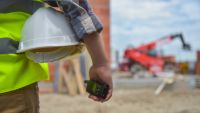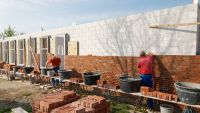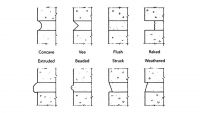
Assessing a masonry building before renovation
Restoration and preservation
By Rhonda Maas
The first step in successfully restoring an historic building is the building assessment, and testing plays a big role. A testing firm should have a specific architectural conservator specialty and experience in testing historic materials: stone, brick and mortar. A structural engineer diagnosing the condition of the building, overall, also should have experience with historic structures.
Some key questions to be answered during the building assessment include:
- How was the building originally constructed?
- Are the problems structural or aesthetic?
- Is the building stable, or is damage continuing?
- What is the source of problems? For example, if there is water damage, how is the water infiltrating?
- What parts of the structure can be repaired and saved?
- What needs to be replaced?
Visual inspection
The first step is a visual inspection. Keep in mind that signs of age do not necessarily mean a serious problem. A hairline crack coming off a window corner, for example, is little more than a cosmetic wrinkle, whereas stairstep cracks along a mortar joint can indicate uneven foundation settling.Another visual inspection tactic is to take several photos of a masonry building two to four hours after a rainstorm or wet spring snow. The building should be dry. If there are wet patches, the water is infiltrating and not drying out quickly enough to avoid freeze-thaw damage. These wet areas indicate trouble spots that need attention.
Original building plans and drawings not only are hard to come by, but also were frequently modified on the fly. Specialty testing firms may employ a variety of non-invasive tests to show how the building actually was constructed in the first place. Tests like microwave radar scanning, sonic testing, infrared thermography and moisture monitoring can determine how the building was put together and how it is performing.
In situ tests for existing structures are available as well. For example, ASTM C 1531 can be used to measure the shear strength of masonry mortar joints. In fact, some building codes in seismic zones require this test to show a building can withstand lateral loads. Two vertical mortar joints around a brick are cleared out. A stainless-steel bladder or “flatjack” attached to a hydraulic pump is inserted into one of the joints. The force it takes to move the brick with the flatjack is measured with a displacement gauge.
The same equipment may be used to perform an ASTM C1197 test for compressive strength or deformability. Two flatjacks are inserted into horizontal mortar joints several brick courses apart. As the hydraulic pump inflates the flatjacks, the displacement of the wall is monitored.
Laboratory testing also plays a role in building assessment. Testing mortar samples to determine the original formulation of lime, cement and sand is helpful for designing a replacement mortar mix. Other tests include thermal and moisture tests of bricks to see if replacement bricks have the same expansion properties as the originals. Waterproofing and patching materials should be tested to assure they match the breathability of the masonry.
On site, the building assessment may reveal flaws in the original construction that need to be addressed. For example, foundation stones may be too porous to stand up to moisture at the water table. Roof trusses may be inadequate or missing. An expansion joint might be needed. Identifying and understanding shortcomings in the original construction can lead to judicious use of sympathetic modern materials and processes.
The building assessment is crucial in setting a budget and timeline for a restoration project. It may even be the deciding point for whether to restore a building. An assessment may reveal that restoring the building would be prohibitively expensive, especially if serious structural and safety issues exist. An investment in a thorough building assessment will anticipate challenges and help keep a project on track.
About the Author
Rhonda Maas is the co-founder and president of Building Restoration Specialties Inc. (BRS), which specializes in masonry restoration, preservation and conservation of historic buildings.


















